Homer 2024 Eagle IPTs
Filling Fast; Early-bird Discount Expiring Soon
Right now, my two 2024 Homer IPTs are half-full only two weeks after being announced. That the two photographers who have already signed up for both 2024 sessions are Homer IPT veterans should tell you something. I am offering an early-bird registration discount that expires at 8:00pm this coming Monday. Click here for discount details.
What’s Up?
Sunday morning dawned completely foggy. It broke through just after 8:00am as I was headed down to the lake. Despite perfect conditions with a brisk east wind, I pretty much came up empty-handed.
Today is Monday 27 March. I will make my way down to the lake early for a short session as I need to pack up and get on the road for the first DeSoto IPT. I am sharing a condo with IPT veteran Bob Handin, the only participant. I go with one. This blog post about two hours to prepare including the time spent on the image optimizations and makes three hundred sixty-one days in a row with a new educational post written just for you. Wherever you are and whatever you are doing, I hope that you too have a great day. My plan is to continue to post every day until the streak reaches one year and one day and then begin posting every other day. It won’t be long now.
Please remember to use the B&H and Amazon links that are found on most blog pages and to use the BIRDSASART discount code at checkout when purchasing your new gear from Bedfords to get 3% back on your credit card and enjoy free second-day air FedEx. Please, also, consider joining a BAA IPT. You will be amazed at how much you will learn!
You can find some great photo accessories (and necessities, like surf booties!) on Amazon by clicking on the Stuff tab on the orange/yellow menu bar above. On a related note, it would be extremely helpful if blog-folks who, like me, spend too much money on Amazon, would get in the habit of clicking on the Amazon logo link on the right side of each blog post when they shop online. As you might expect, doing so will not cost you a single penny, but would be appreciated tremendously by yours truly. And doing so, works seamlessly with your Amazon Prime account.
Please remember that if an item — a Delkin flash card, or a tripod head — for example, that is available from B&H and/or Bedfords, is also available in the BAA Online Store, it would be great, and greatly appreciated, if you would opt to purchase from us. We will match any price. Please remember also to use my B&H affiliate links or to earn 3% cash back at Bedfords by using the BIRDSASART discount code at checkout for your major gear purchases. Doing either often earns you free guides and/or discounts. And always earns my great appreciation.
|
|
|
This image was created on 22 February 2023 by Bob Eastman on an Instructional Photo-Tour at Kachemak Bay, Homer, AK. He used the handheld Sony FE 70-200mm f/2.8 GM OSS II lens with the Sony FE 1.4x Teleconverter (at 280mm) and The One, the Sony Alpha 1 Mirrorless Digital Camera.. The exposure was determined via Zebras with ISO on the Thumb Dial. ISO 6400: 1/3200 sec. at f/4 (wide open) in Manual mode. AWB at 3:56:37am on a cloudy afternoon. Tracking: Zone AF/C with Bird-Eye/Face Detection performed perfectly. Click on the image to enjoy a high-res version. Image #1: Bald Eagle juvenile picking up Surf Scoter carcass |
What Bob Learned on the Homer IPTs Part I
Bob learned not to be concerned about high ISO settings with Sony. In very low light, he had raised the ISO to 2500 for the adult eagles with their white heads. When he saw the young bird coming in, he quickly increased the ISO four clicks (1 1/3-stops) to ensure a good exposure for the darker young bird. As instructed.
|
|
|
This image was created on 23 February 2023 by Bob Eastman on an Instructional Photo-Tour at Kachemak Bay, Homer, AK. He used the handheld Sony FE 70-200mm f/2.8 GM OSS II lens (at 200mm) and The One, the Sony Alpha 1 Mirrorless Digital Camera.. The exposure was determined via Zebras with ISO on the Thumb Dial. ISO 1250: 1/2500 sec. at f/2.8 (wide open) in Manual mode. AWB at 11:33:42am on a cloudy morning. Tracking: Expand Spot AF/C with Bird-Eye/Face Detection performed perfectly. Click on the image to enjoy a high-res version. Image #2: Bald Eagle scavenging Moose rack |
What Bob Learned on the Homer IPTs Part II
Bob learned that patience paid off. He wanted an image of the eagle inside the Moose antlers and stayed with it until he got what he wanted. He needs to teach me that lesson.
|
|
|
This image was created on 4 March 2023 by Bob Eastman on an Instructional Photo-Tour at Kachemak Bay, Homer, AK. He used the handheld Sony FE 70-200mm f/2.8 GM OSS II lens with the Sony FE 1.4x Teleconverter (at 263mm) and The One, the Sony Alpha 1 Mirrorless Digital Camera.. The exposure was determined via Zebras with ISO on the Thumb Dial. ISO 800: 1/3200 sec. at f/4 (wide open) in Manual mode. AWB at 8:57:23am on a cloudy-bright morning. Tracking: Zone AF/C with Bird-Eye/Face Detection performed perfectly. Click on the image to enjoy a high-res version. Image #3: Bald Eagle adult banking to begin dive
|
What Bob Learned on the Homer IPTs Part III
Bob learned how to get the right exposure for the adult eagles on white sky days: set the wide open aperture, pick your preferred fast shutter speed for flight, and then raise the ISO until the analogue scale shows +2 stops on the sky. Bob took every word that I said as the holy grail. That paid off nicely on the IPT and will continue paying off until he falls off another cliff. Or not!
|
|
|
This image was created on 4 March 2023 by Bob Eastman on an Instructional Photo-Tour at Kachemak Bay, Homer, AK. He used the handheld Sony FE 70-200mm f/2.8 GM OSS II lens with the Sony FE 2x teleconverter (at 374mm) and The One, the Sony Alpha 1 Mirrorless Digital Camera.. Exposure Compensation was on the Thumb Dial. Multi-metering -.7 stops. AUTO ISO set ISO 250: 1/2500 sec. at f/6.3 (stopped down 1/3-stop) in Shutter Priority mode. AWB at 6:05:50pm on a variably sunny afternoon. Tracking: Zone AF/C with Bird-Eye/Face Detection performed perfectly. Click on the image to enjoy a high-res version. Image #4: Bald Eagle taking flight at sunset |
What Bob Learned on the Homer IPTs Part IV
Bob learned to shoot sunsets in Shutter Priority mode with Exposure Compensation on the Thumb Dial. And after the fact, he learned that he needs to always add light for silhouettes when the sun is not in the frame — as much as 2 2/3-stops depending on the brightness of the sky color. The raw file for this image was more than two stops under-exposed.
|
|
|
This image was also created on 4 March 2023 by Bob Eastman on an Instructional Photo-Tour at Kachemak Bay, Homer, AK. He used the handheld Sony FE 200-600mm f/5.6-6.3 G OSS lens (at 600mm) and The One, the Sony Alpha 1 Mirrorless digital camera. ) The exposure was determined using Zebra technology with Exposure Compensation on the Thumb Dial. Multi-metering +.3 stops. AUTO ISO set ISO 250: 1/2500 sec. at f/6.3 (stopped down 1/3-stop) in Shutter Priority mode. Tracking: Expand Spot AF/C with Bird-Eye/Face Detection performed perfectly. Click on the image to enjoy a high-res version. Image #5: Bald Eagle — large in the frame sunset silhouette |
What Bob Learned on the Homer IPTs Part V
Bob learned that to get the brightest sunset or sunrise colors, put the subject directly between you and the sun. While that seems obvious, folks often seem to miss that important point.
|
|
|
This image was created on 5 March 2023 by Bob Eastman on an Instructional Photo-Tour at Kachemak Bay, Homer, AK. He used the handheld Sony FE 200-600mm f/5.6-6.3 G OSS lens (at 600mm) and The One, the Sony Alpha 1 Mirrorless digital camera. ) The exposure was determined using Zebra technology with ISO on the Thumb Dial. ISO 2000. 1/2500 sec. at f/4 (wide open) in Manual mode. Tracking: Expand Zone AF/C with Bird-Eye/Face Detection performed perfectly. Click on the image to enjoy a high-res version. Image #6: Bald Eagle midair confrontation |
What Bob Learned on the Homer IPTs Part VI
Bob learned that when you have two flying birds in the frame, press the shutter button. Do not try to visualize the perfect image. Do not try to compose a pleasing image. Press the shutter button.
|
|
|
This image was created on 7 March 2023 by Bob Eastman on an Instructional Photo-Tour at Kachemak Bay, Homer, AK. He used the handheld Sony FE 70-200mm f/2.8 GM OSS II lens (at 200mm) and The One, the Sony Alpha 1 Mirrorless Digital Camera.. The exposure was determined via Zebras with ISO on the Thumb Dial. ISO 400: 1/4000 sec. at f/3.5 (stopped down 1/3-stop) in Manual mode. AWB at 9:36:36am on a sunny morning. Tracking: Zone AF/C with Bird-Eye/Face Detection performed perfectly. Click on the image to enjoy a high-res version. Image #7: Bald Eagle in flight over distant snow-covered mountains and fog bank |
What Bob Learned on the Homer IPTs Part VII
Bob learned to use short focal lengths to create bird-scapes. Bob learned to select the best wing positions from a long series of sharp images. And he learned to make perfect exposures in both low light and full sun. RawDigger showed the raw file for this image to be dead-solid perfect.
Remember: in low light with light-toned backgrounds even the most sophisticated in-camera meters are dumber than a skunk. They are a lot smarter on sunny days.
You Know the Drill
Which of Bob Eastman’s seven featured images do you think is the strongest? Those who leave a comment are invited to let us know why they made their choice. Though all of Bob’s images are very strong, I do have a clear favorite. Let’s see if anyone likes my pick!
|
|
|
2024 Homer/Kachemak Bay Bald Eagle IPTs
IPT #1: WED 21 FEB 2024 through the full day on SUN 25 FEB 2024. Five full days/20 hours on the boat: $5500.00. Limit 5 photographers/Openings 3.
IPT #2: MON 26 FEB 2024 through the full day on FRI 1 MAR 2024. Five full days/20 hours on the boat: $5500.00. Limit 5 photographers/Openings 2.
Register for both trips to maximize your travel dollars and enjoy a $1000 discount while you are at it.
This trip features non-stop flight photography as well as many opportunities to create both environmental and point-blank portraits of one of North America’s most sought-after avian subjects: Bald Eagle (Haliaeetus leucocephalus). Other reliable subjects will include Sea Otter, Glaucous-winged and Short-billed (formerly Mew) Gulls.
In addition, we should see Common Murre, Black Guillemot, Pelagic Cormorant, two or three species of loons, and a smattering of ducks including two species of merganser, all three scoters, Common and Barrow’s Goldeneyes, Bufflehead, Harlequin, and Long-tailed Ducks. Close-range photographic chances for these species will require some good luck. Some of these species, especially when in flocks, can, however, often be used effectively when pleasing creating bird-scapes.
If we need to be out early, we will be the first boat out. If the conditions are great, we will stay out. And when there is a chance for sunset silhouettes, we will be in the right spot.
We will be traveling through gorgeous wilderness country; landscape and scenic opportunities abound.
Also featured is a professional leader, often referred to as the world’s most knowledgeable bird photography trip leader and instructor. He is conversant in Canon, Nikon, and Sony. You will learn practical and creative solutions to everyday photographic problems. You will learn to see the shot, to create dynamic images by fine-tuning your compositions, to best utilize your camera’s AF system, and how to analyze the wind, the sky conditions, and the direction and quality of the light. This is one of the very few trips Homer trips available where you will not be simply put on the birds and told to have fun. You will learn to be a better photographer. But only if that is what you want.
You will learn to get the right exposure when it is sunny, when it cloudy-bright, when it is cloudy, when it is cloudy-dark, or when it is foggy. Not to mention getting the right exposure when creating silhouettes.
You will learn to make pleasing blurs working in manual mode and to create silhouettes working in Shutter Priority mode.
Most importantly you will learn to pick your best flight photographs from tens of thousands of images.
You will enjoy working with the best and most creative boat captain on his sturdy, photography-spacious, seaworthy, open-deck watercraft.
Only five photographers (not the usual six), plus the leader.
Small group Photoshop, Image Review, and Image Critiquing sessions.
|
|
All images from Homer or Kachemak Bay, AK |
What’s Included
One four hour or two two-hour boat trips every day (weather permitting), all boat fees and boat-related expenses (excluding tips), ground transportation to and from the dock and back to the hotel each day, in-the-field instruction and guidance, pre-trip gear advice, small group post-processing and image review sessions, and a thank you dinner for all well-behaved participants.
What’s Not Included
Your airfare to and from Homer, AK (via Anchorage), the cost of your room at Land’s End Resort, all personal items, all meals and beverages, and tips for the boat captain and/or the first mate.
Please Note
On great days, the group may wish to photograph for more than four hours. If the total time on the boat exceeds 20 hours for the five-day trips the group will share the additional expense at a rate of $225/hour. The leader will pay for the bait.
Some folks may wish to rent their own vehicle to take advantage of local photographic opportunities around Homer. In 2023 those included Moose, Great Grey, and Short-eared Owls.
Deposit Information
A $3000 non-refundable deposit/trip is required. You may pay your deposit with credit card or by personal check (the latter made out to BIRDS AS ART) and sent via US mail only to Arthur Morris. PO Box 7245. Indian Lake Estates, FL 33855. Your balance, due 90 days before the date of departure, is payable only by check (as above).
In Closing
I have been going to Homer off and on for close to two decades. Every trip has been nothing short of fantastic. Many folks go in mid-March. The earlier you go, the better the chances for snow. The only way to assure that you are on the best of these two trips is to sign up for all of them. Can you keep up with me? If you have any questions, or are good to go for one, or two of these great trips, please let me know via e-mail or give me a call on my cell phone at 863-221-2372.
Typos
With all blog posts, feel free to e-mail or to leave a comment regarding any typos or errors.

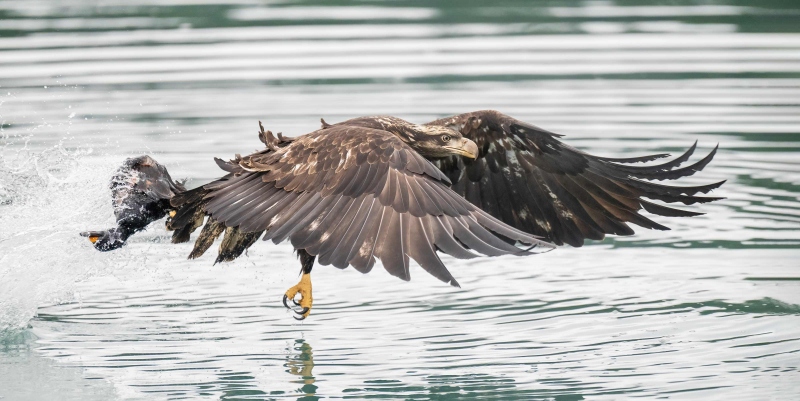
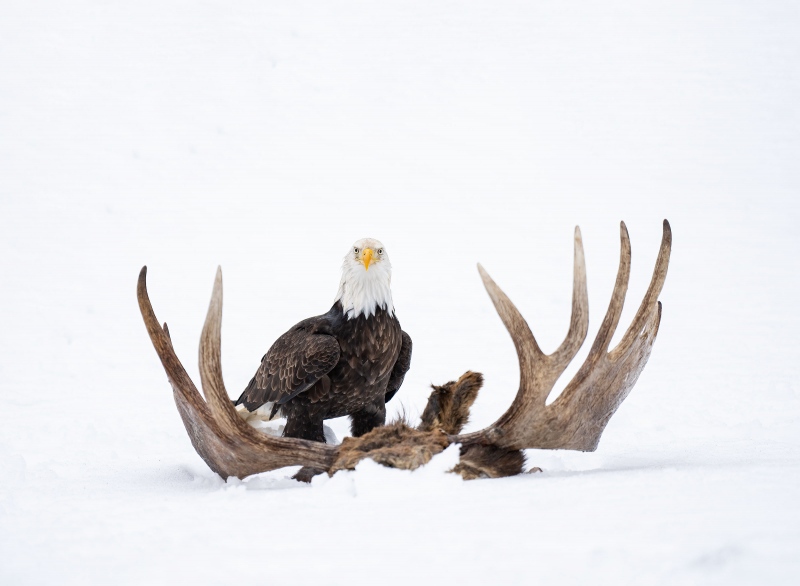
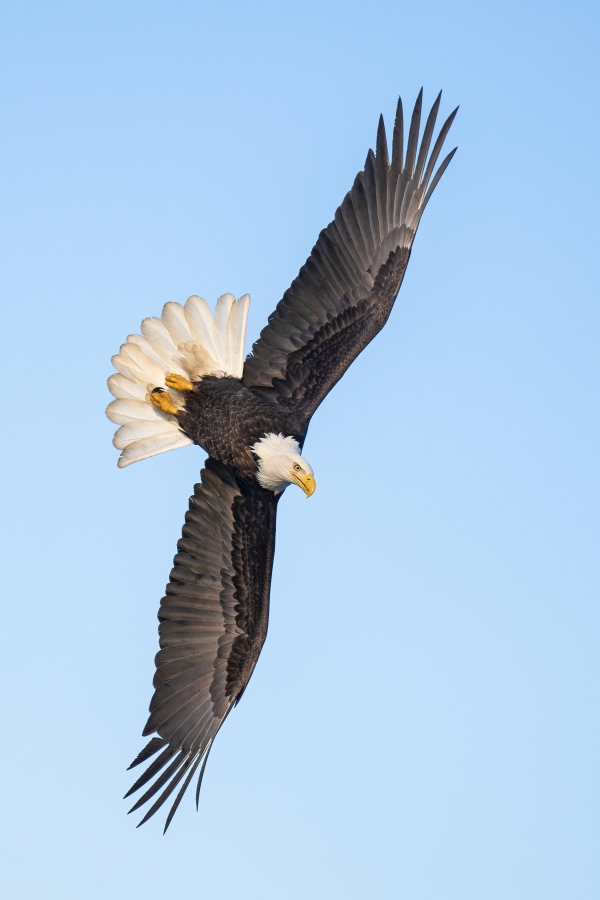
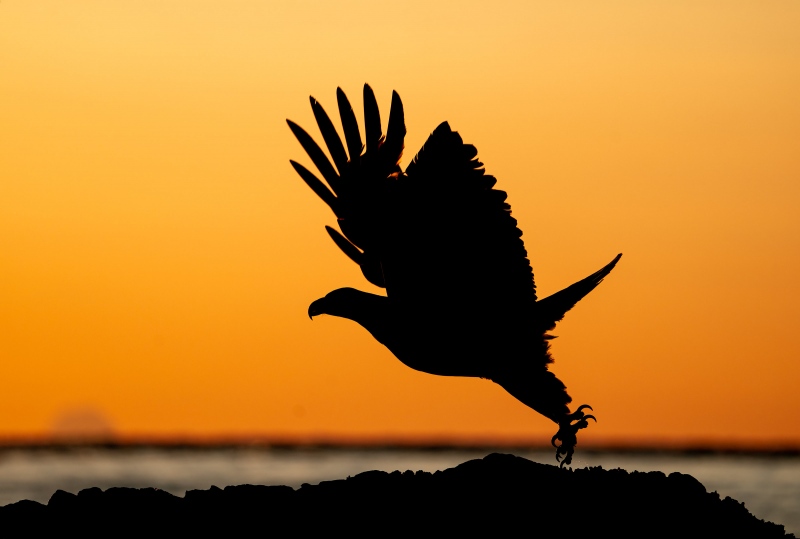
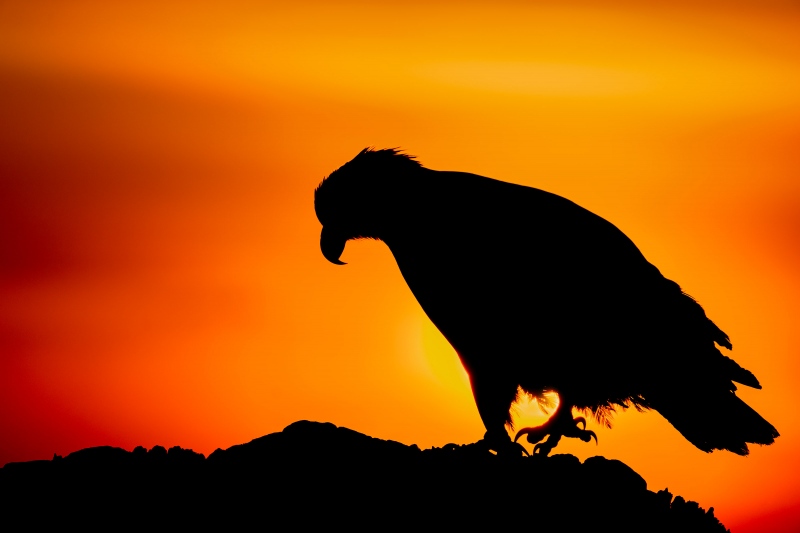
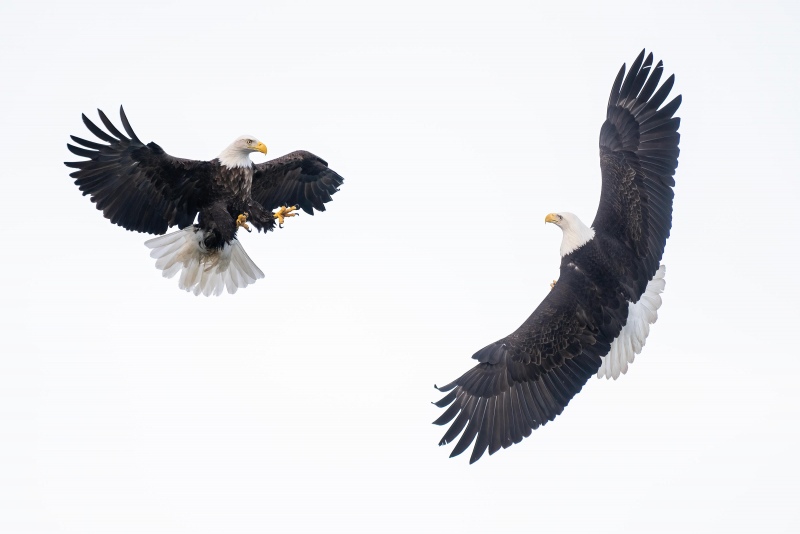
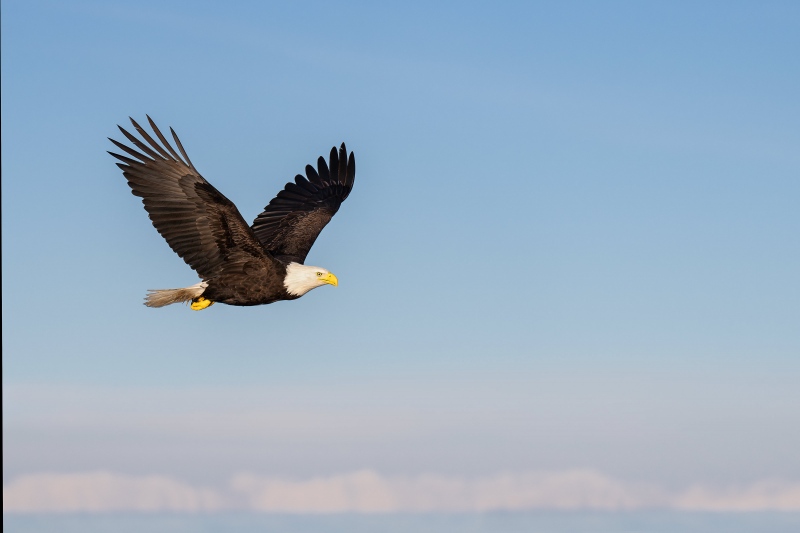
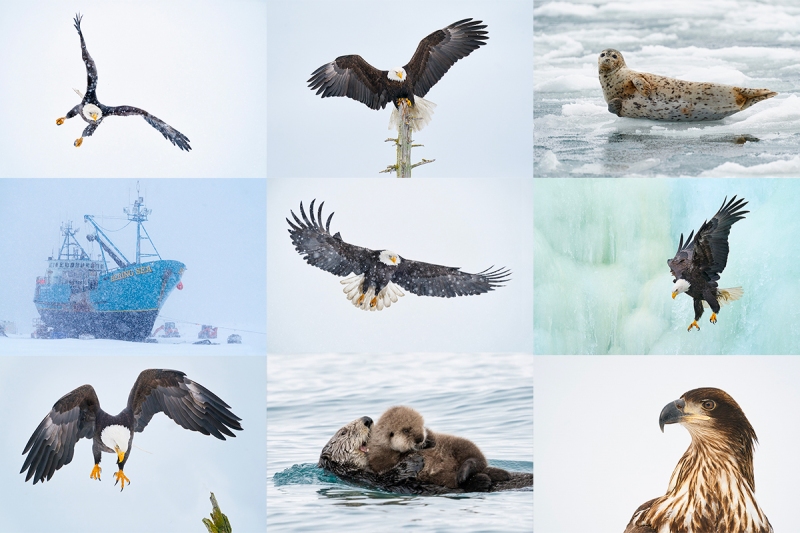
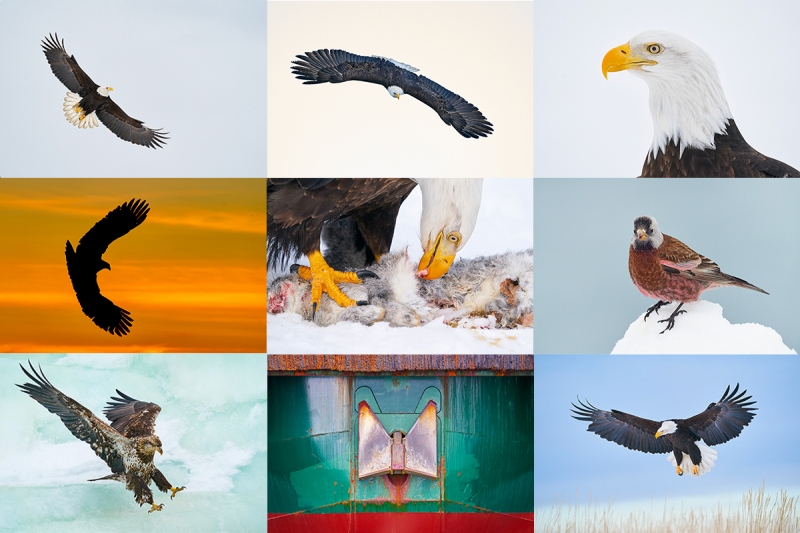













I think we all made a new friend…. Great shots. I like the eagle in the rack and the more colorful sunset silhouette. Artie your always so kind with YOUR blog & humble in sharing it with others. Although a tiny bit braggadocios’ on your immeasurable teaching skills and your new protégé.
😉
I think all are striking but would pick the silhouette, #5 because of the strong colors, bird position, and sharpness.
Thanks, Dick. That would be my second pick.
a
IMO the strongest image is #1. It would be very difficult for a non-professional to get all of the eagle and carcass in the frame and for the image to be sharp. Kudos to Bob!
All images #1 and #2 and #3 and #4 and #5 and #6 and #7 are interesting. In image#4 and #5 are hard to know that is Bald Eagle because it is so dark.
Not really 🙂
a
Strong images, but my favorites are Images 3 and 4. Artie may be looking for something different now, but for me, having only been to Homer with film, a high-resolution perfect flight shot is very appealing. For something different, Image 4 combines color, action, and environment (with layers of rock, bay, and spit (?), and even a volcano in the far distance)–call the Alaska Bureau of Tourism!
My picks are #2 and 6. #2 because the great framing of the antlers is unique. And #6 because getting the squabbling behavior with both birds sharp and in good composition is unique. All are great photos !
Artie
WOW what an amazing blog post! It looks great.
Thank you artie a million times over for helping me learn to make better pictures. For helping me with the skills needed to see the shot, to adjust the settings, to maybe move a step to the side or get a bit higher or lower, and to create something of beauty.
Love you much my friend b
Thanks Bob. I agree! And I love working with students who work hard, are super-eager to learn, and soak everything up like a dry sponge.
much love, a
ps: it is always great making new friends!